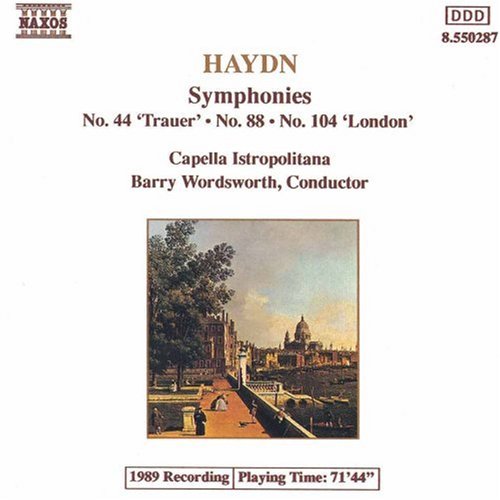Disco de Franz Joseph Haydn: «Haydn: Symphonies Nos. 44, 88, 104»

- Valoración de usuarios: (5.0 de 5)
- Título:Haydn: Symphonies Nos. 44, 88, 104
- Fecha de publicación:1994-02-15
- Tipo:Audio CD
- Sello discográfico:Naxos
- UPC:730099528726
- 1Symphony No. 44 In E Minor 'Trauer': Allegro con brio
- 2Symphony No. 44 In E Minor 'Trauer': Menuetto:Allegretto
- 3Symphony No. 44 In E Minor 'Trauer': Adagio
- 4Symphony No. 44 In E Minor 'Trauer': Finale: Presto
- 5Symphony No. 88 In G Major: Adagio - Allegro
- 6Symphony No. 88 In G Major: Largo
- 7Symphony No. 88 In G Major: Menuetto: Allegretto
- 8Symphony No. 88 In G Major: Finale: Allegro con spirito
- 9Symphony No. 104 In D Major 'London': Adagio-Allegro
- 10Symphony No. 104 In D Major 'London': Andante
- 11Symphony No. 104 In D Major 'London': Menuetto: Allegro
- 12Symphony No. 104 In D Major 'London': Finale: Spiritoso
Haydn wrote 104 symphonies, of which the last is presented on this disc played by the Capella Istropolitana, a group little known in the United States but of increasing repute in Europe. And you see why on this disc. They succeed wildly in playingg Haydn in a way that captures the spirit and freshness of his work. And tey do it as well as, if not better than, other well established orchestras. The three symphonies are played perfectly. And with Haydn that is saying a lot. He is recognized today as te "father" of the symphony, not because he created the art form. He did't. There were symphonies before him, but they sounded nothing like they do today. It was Haydn who shaped and developed the symphony into the mature Classical form. No. 44 is easily recognized as a modern symphony with four movements. It is a pleasant work but certainly is not ranked among Haydn's more important works; rather, it gives the promise of greater things to come. Haydn was a devout man and he once said that since God had given him a sunny disposition he was pleased to let this be reflected in his music. His music is filled with beautiful melodies for which he seemed to havr an inexhaustible supply. And while others might say they are charming, I prefer to say they are graceful. Symphony No.88 represents yet another advancement in Haydn's growth as a composer. It remains one of Haydn's more popular symphonies and is often recorded and played on the concert stage. As noted by the previous review, it has more weight to it and is stately in its conception. The jewel of the disc, however, is Symphony No.104, easily one of those few symphonies to rank with the greatest ever written. This is Haydn in the full reflection of his genius. Combining everything he had learned about symphonic composition, and written with his innate sense of style and , again, grace, No. 104, especially as played here, is joy to listen to, once and often.
A word about the Capella Istropolitana. I grew up in an age when symphonies were weighty and sometimes ponderous. My introduction to Haydn's No. 104 was Otto Klemperer and the Philharmonia Orchestra. His interpretation was mighty, majestic and grand and beautifully done. Here the beauty is reveled in a more intimate scale. The Capella Istropolitana is a smaller orchestra that plays with a lighter touch. It is one that I believe suits Haydn wonderfully well. Haydn is not Mozart, nor is he Beethoven. His work does not have their power, nor their dynamic
range. His genius was to bring us to the doorstep of these two other giants of music. In doing so, he also left us a body of work that is perhaps the most beautiful in all the history of music.
One final note of thianks to Naxos: They have gathered all teir various recordings of the Haydn symphonies into a complete boxed set. The symphonies are played by about six different European chamber orchestras (and one Canadian), with the Capella Istropolitana handling most of the latter ones. It is beautifully done and well worth looking into.
Even though I do not understand why Naxos uses symphonies from several parts of the cycle, these symphonies are very well conduced by Barry Wordsworth under the Capella Istropolitana. As always Naxos provides ample notes that allow understanding of the symphonies
. Symphony 44 nicknamed Trauer or mourning because Haydn wanted the quite beautiful Adagio to be used at his funeral. This is one of Haydn's Sturm und Drang symphonies which he uses choppy rhythms. The Adagio my favorite part opens with muted strings, then oboes and horns brought tears to my eyes.
Symphony No. 88 is one that Tost who was violinist with the Esterhazy orchestra and dedicee of 4 sets of string Quartet and introduced to Paris is a lot meatier than 44 in terms of musical ideas begins with a slow introduction then into a cheerful allegro, the slow movement is beautiful here in which the oboe and cello announce the theme. I also fund the Menuetto and concluding Rondo quite beautiful.
Symphony 104 "London" is his final symphony and is scored for flutes, bassoons, horns, trumpets, drums as well as the usual strings was commissioned for the London season. Haydn definitely demonstrates his decades of composional skill in this symphony which draws you in immediately, This symphony again begins with a slow adagio followed by the allegro has many enchanting themes, Then a ten minute adagio which begins with strings, the Menuetto is quite rightly remembered as one of the most memorable moments in any of the symphonies (wow) which is followed by a spirituoso that has the contours of folk song.
Please excuse typos I have a neurologic disease

